HTC MAGICIAN Dual Mode GSM850/1900 & 2.4 GHz FHSS PDA Phone User Manual Magician CDL Manual English Book indb
HTC Corporation Dual Mode GSM850/1900 & 2.4 GHz FHSS PDA Phone Magician CDL Manual English Book indb
HTC >
Contents
- 1. Users Manual Part I
- 2. Users Manual Part II
Users Manual Part I
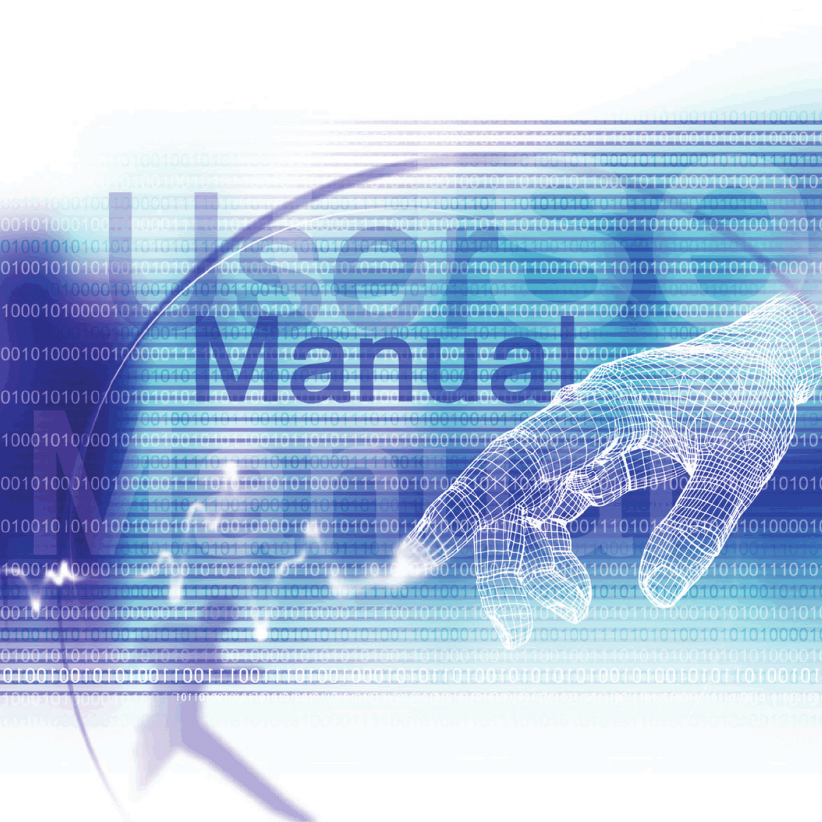
Pocket PC Phone

Pocket PC Phone User Manual2
Pocket PC Phone User Manual 3
Please Read Before Proceeding
THIS DEVICE IS NOT CHARGED WHEN YOU TAKE IT OUT OF THE BOX.
DO NOT REMOVE THE BATTERY PACK WHEN THE DEVICE IS CHARGING.
WHEN INSERTING YOUR SIM CARD, MAKE SURE THE DEVICE IS POWERED OFF, AND
THAT THE SIM CARD SNAPS INTO THE SOCKET.
YOUR WARRANTY IS INVALIDATED IF YOU OPEN OR TAMPER WITH THE DEVICE’S OUTER
CASING.
EXPLOSIVE ATMOSPHERES
When in any area with a potentially explosive atmosphere or where ammable materials exist, the product
should be turned off and the user should obey all signs and instructions. Sparks in such areas could cause an
explosion or re resulting in bodily injury or even death. Users are advised not to use the equipment at refueling
points such as service or gas stations. Users are reminded of the need to observe restrictions on the use of radio
equipment in fuel depots, chemical plants or where blasting operations are in progress. Areas with a potentially
explosive atmosphere are often, but not always, clearly marked. These include fuelling areas, below deck on
boats, fuel or chemical transfer or storage facilities, and areas where the air contains chemicals or particles,
such as grain, dust, or metal powders.
PRIVACY RESTRICTIONS
Some countries require full disclosure of recorded telephone conversations, and stipulate that you must inform
the person with whom you are speaking that the conversation is being recorded. Always obey the relevant laws
and regulations of your country when using the recording feature of your Pocket PC Phone.

Pocket PC Phone User Manual2
Pocket PC Phone User Manual 3
Important Safety Precautions
When using this product, the safety precautions below must be taken to offset possible legal
liabilities and damages.
n ELECTRICAL SAFETY
This product is intended for use when supplied with power from the battery. Other usage may be
dangerous and will invalidate any approval given to this product.
n SAFETY IN AIRCRAFTS
Due to the possible interference caused by this product to an aircraft's navigation system and
its communications network, using this product on board an airplane is against the law in most
countries.
n ENVIRONMENT RESTRICTIONS
Do no use this product at gas or refueling stations. The use of this product is also prohibited in fuel
storehouse, chemical plants, and locations containing explosives.
n ROAD SAFETY
Vehicle drivers in motion are not permitted to use telephony services with handheld devices,
except in the case of emergency. In some countries, using hand-free devices as an alternative
is allowed.
n INTERFERENCE WITH MEDICAL EQUIPMENT FUNCTIONS
This product may cause medical equipment to malfunction. The use of this device is forbidden in
most hospitals and medical clinics.
n NONIONIZING RADIATION
This product should be operated in the suggested normal condition only to ensure the radiative
performance and safety of the interference. As with other mobile radio transmitting equipment,
users are advised that for satisfactory operation of the equipment and for the safety of personnel,
it is recommended that no part of the human body be allowed to come too close to the antenna
during operation of the equipment.

Pocket PC Phone User Manual4
Pocket PC Phone User Manual 5
Contents
Chapter 1 Getting Started
1.1 Knowing Your Device ...................10
1.2 Inserting the SIM Card ...............12
1.3 Battery .........................................13
1.4 Accessories...................................15
Chapter 2 Knowing Your Pocket PC
Phone
2.1 Starting Up ...................................18
2.2 Entering Information ...................25
2.3 Phone Pad ....................................30
2.4 Writing on the Screen ..................33
2.5 Drawing on the Screen.................35
2.6 Recording a Message ...................36
2.7 Finding Information .....................38
Chapter 3 Using Your Pocket PC
Phone
3.1 About Your Pocket PC Phone .......42

Pocket PC Phone User Manual4
Pocket PC Phone User Manual 5
3.2 Making a Call................................46
3.3 Smart Dialing ...............................49
3.4 Receiving a call ............................52
3.5 In-Call Options .............................53
3.6 Contacts Information...................55
3.7 Photo Contacts.............................57
3.8 Additional Dialing Information ....64
3.9 Securing Your Pocket PC Phone...65
Chapter 4 Synchronizing Information
4.1 Using ActiveSync..........................68
4.2 Synchronizing Information ..........70
4.3 Infrared and Bluetooth
Connection ...................................73
4.4 ActiveSync Errors .........................74
Chapter 5 Personalizing Your MDA
Compact
5.1 Device Settings ............................76
5.2 Phone Settings .............................84

Pocket PC Phone User Manual6
Pocket PC Phone User Manual 7
Chapter 6 Getting Connected
6.1 About Connections .......................88
6.2 Connecting to the Internet ..........88
6.3 CSD Line Type ..............................90
6.4 Pocket Internet Explorer .............91
6.5 Network Cards Settings ...............92
6.6 Terminal Services Client ..............93
6.7 Bluetooth......................................94
6.8 Wireless Modem.........................100
Chapter 7 Using Outlook
7.1 Calendar .....................................106
7.2 Contacts .....................................108
7.3 Tasks ..........................................111
7.4 Notes ..........................................112
Chapter 8 Massaging Features
8.1 E-Mail and Text Messages..........116
8.2 MSN Messenger..........................121

Pocket PC Phone User Manual6
Pocket PC Phone User Manual 7
8.3 MMS Messages ...........................121
Chapter 9 Applications
9.1 Pocket Word...............................132
9.2 Pocket Excel ...............................133
9.3 Windows Media Player...............134
9.4 Pictures ......................................135
9.5 Truefax .......................................139
9.6 MIDlet Manager .........................143
Chapter 10 Using Camera and Album
10.1 About Camera and Album ..........152
10.2 Camera .......................................153
10.3 Album ........................................165
Appendix A
Adding or Removing Programs ..........176
Managing Memory..............................178
Backing Up Files .................................180
Resetting Your Pocket PC Phone ......181

Pocket PC Phone User Manual8
Appendix B
Regulatory Agency IDs........................184
European Union Notice........................184
FCC Compliance Statement .................186
Important Health and Saftey
Information.........................................188
Troubleshooting..................................191
Specications 197
Index 198

Chapter 1
Getting Started
1.1 Knowing Your Device
1.2 Inserting the SIM Card
1.3 Battery
1.4 Accessories
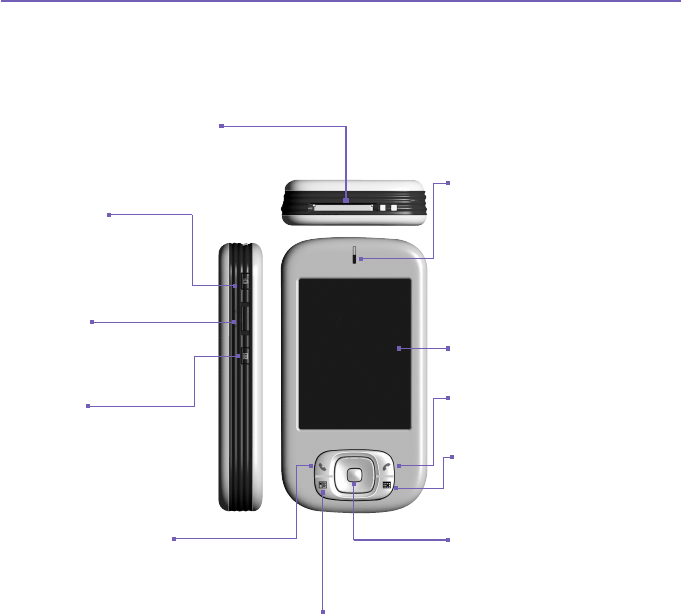
Pocket PC Phone User Manual10
Pocket PC Phone User Manual 11
1.1 Knowing Your Device
Top View, Left-Side View, and Front View
Navigation Pad
Press to move up/down
and left/right through any
of the drop-down menus
or program instructions;
select by pressing the Action
key on the center of the pad.
Calendar
Press for quick access to your
calendar.
Volume
Press UP/DOWN to adjust
the volume.
Record
Long press to record a
voice note.
End
Press to end a call.
Notication LEDs
GSM standby, message,
GSM network status, PDA
notication, Bluetooth, power
notication and battery charge
status.
MMC/SD or SDIO slot
Insert MMC card or a SDIO
Accessory here.
Camera
Press to launch Camera.
Press again to take a
picture.
Talk/Send
Press to answer an
incoming call or dial a
number.
Contacts
Press for quick access
to your contacts.
Touch Screen
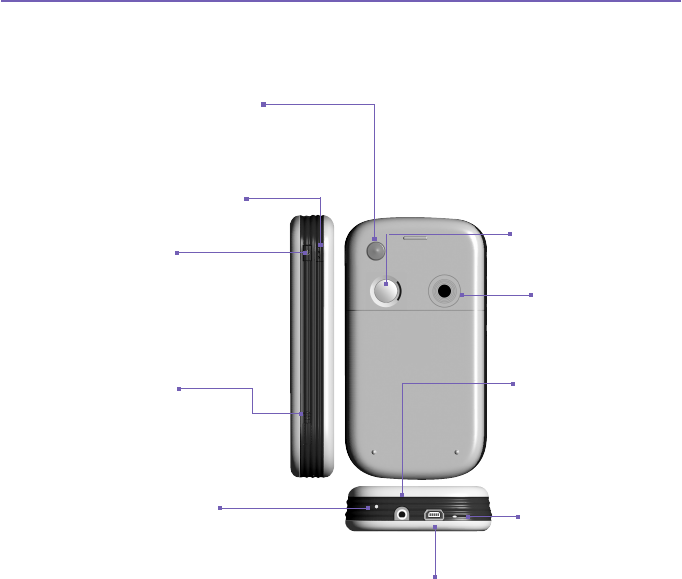
Pocket PC Phone User Manual10
Pocket PC Phone User Manual 11
Right-Side View, Back View, and Bottom View
Earphone Plug
Allows you to listen
to audio media
or use the phone
hands-free kit.
Soft Reset
Press here with stylus
to reset your device.
Microphone
Speak here when
receiving/making a
phone call or voice
recording.
Mini USB Connector
Use this connector to
synchronise, transmit data or
recharge the battery.
Infrared Port
Enables to exchange le(s)
or data with other devices
without cables or wires.
Self-portrait
mirror
Camera Lens
Car Antenna Connector
You can connect your phone to a car
antenna to utilize the superior reception
quality.
Stylus and Stylus Slot
Power Button/
Backlight
Press to turn ON/OFF your
device or backlight.
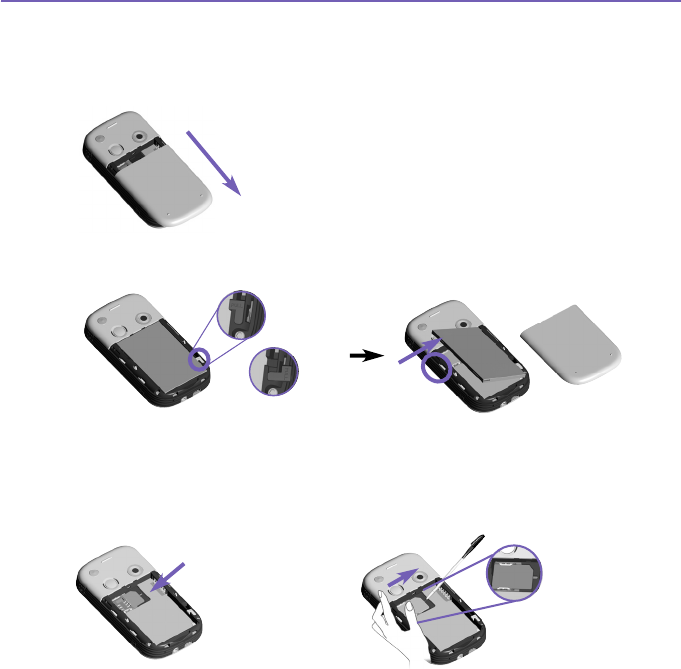
Pocket PC Phone User Manual12
Pocket PC Phone User Manual 13
1.2 Inserting the SIM Card
1. Ensure the device is turned off.
2. Turn your device over and press the back cover lightly to slide out the back cover.
3. Switch the red battery lock to release the battery pack. Then, use your nger to lift up
the battery from the left side of the battery slot.
4. Insert the SIM card with its gold contacts face down. Its cut off corner should match the
cut off corner in the slot. If you wish to take the SIM card out, use the stylus to press into
the SIM card slot hole, and then lightly lift up the SIM card while pressing the left-most
side of the SIM card, and then slide it out.
locked
unlocked
Slide the SIM
card into the
SIM card slot.
Press lightly to
slide the SIM
card out.
Use the stylus to
press into the SIM
card slot hole.

Pocket PC Phone User Manual12
Pocket PC Phone User Manual 13
1.3 Battery
Your Pocket PC Phone contains a rechargeable Li-ion polymer battery. Battery life depends
on whether you are talking on the phone, using the PDA, or if the device is on standby.
Battery life estimates:
n Talk-time: 3 - 5 hrs.
n PDA: 11 hrs (approximate.).
n Standby: 190 hrs (approximate.).
n Data retention time: 72 hrs.
The above are based on using one function at a time. Battery life
may vary with switching between functions.
WARNING: To reduce the risk of re or burns, do not disassemble, crush, puncture, short
external contacts, heat above 60℃ (140℉), or dispose of in re or water. Replace only
with manufacturer specied batteries. Recycle or dispose of used batteries as stipulated
by local regulations.
Data retention
It is vital to keep your battery charged. This is because your Pocket PC Phone does not
have a hard drive, all data and any new programs you install are stored in the RAM. If the
battery completely drains, any data or new programs you installed will be erased. Only the
default programs that came with the device at the time of purchase will remain.
5. Replace the battery by inserting the right side rst. Then, push back the red battery lock
into place to x the battery.
6. To replace the back cover, lay it on the back of the device, lining up the grips on the upper
side of the back cover with the slots on the side of the device. Finally, slide forward to
snap into place.
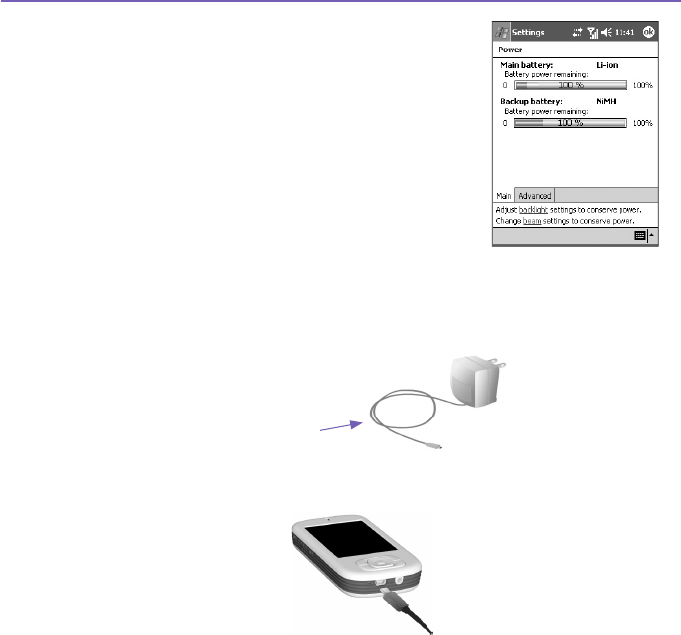
Pocket PC Phone User Manual14
Pocket PC Phone User Manual 15
To prevent this kind of data loss, a portion of the main
battery will keep your data safe for 72 hours if your
device runs out of power. An additional battery, the
internal backup battery, is designed to keep your data
safe when you remove the main battery. It will keep the
data safe for 30 minutes.
NOTE: Be sure to check that the internal backup battery
power remains at least at 50% OR ABOVE before you
remove the main battery by tapping the Start menu >
Settings > the System tab > Power.
Recharging your device
You can recharge your device in the following ways:
1. Connect your Pocket PC Phone directly to the AC adapter that is provided.
2. You can also charge your Pocket PC Phone by plugging the Sync cable into
your PC's USB port.
Plug the AC adapter
into an electrical outlet
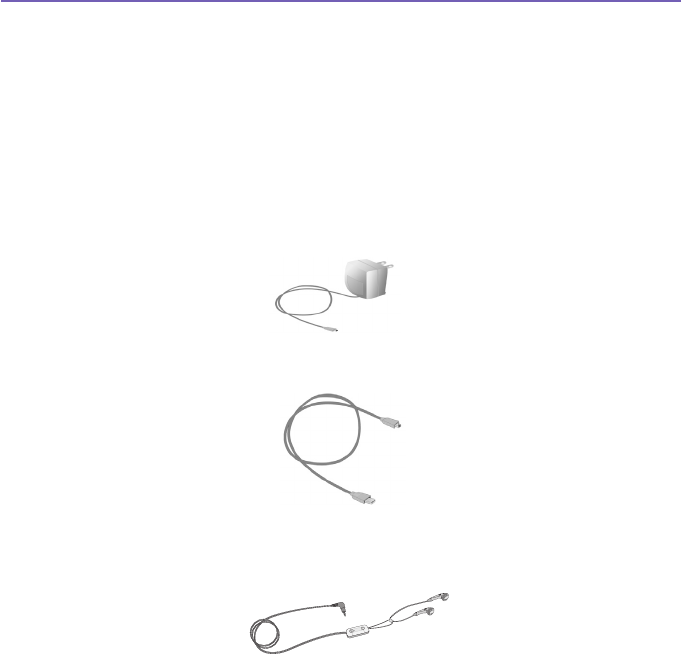
Pocket PC Phone User Manual14
Pocket PC Phone User Manual 15
When the battery is low
When the low-battery warning message appears, immediately save any data you are
working on, perform synchronization with your PC, and turn off your Pocket PC Phone. The
internal backup battery can only protect the data in case of battery or SIM card change.
Data retention in the case of shut down (low battery) is 72 hours.
1.4 Accessories
AC Adapter
The AC adapter allow you to recharge your Pocket PC Phone.
USB Cable
The optional USB cable allows you to synchronize with a PC .
Headset
The stereo handset has a volume control and a button where press once to pick up a
phone call and hold 2 seconds to end a phone call. During a phone call, press once to
switch between calls.

Pocket PC Phone User Manual16

Chapter 2
Knowing Your Pocket PC
2.1 Starting Up
2.2 Entering Information
2.3 Phone Pad
2.3 Writing on the Screen
2.4 Drawing on the Screen
2.5 Recording a Message
2.6 Finding Information

Pocket PC Phone User Manual18
Pocket PC Phone User Manual 19
2.1 Starting Up
Turning Your Pocket PC Phone On and Off
To turn your device on:
Press the Power Button on the right side of the device. (The Pocket PC Phone will power
up and, if this is the rst time it has powered up, will automatically begin the initiation/
calibration process. See below for further details.)
To turn your device off:
Press the Power Button on the right side of the device.
Note: Turning your device off doesn’t turn the phone off. To turn the phone off, select the
GSM icon and select "Turn on ight mode".
Screen tapping and calibration
When you rst start up your Pocket PC, you will be asked to calibrate the screen by tapping
the center of a cross with your stylus as it moves around the screen. This process ensures
that when you tap the screen with your stylus, the tapped item is activated.
Re-calibrate the screen
If your Pocket PC Phone does not accurately respond to screen taps, you will need to
re-calibrate it:
1. Tap the Start menu > Settings > the System tab > Screen.
2. Tap the Align Screen button on the General tab to re-calibrate the screen as described
above.
Note: When aligning the touch screen, tap the target rmly and accurately.
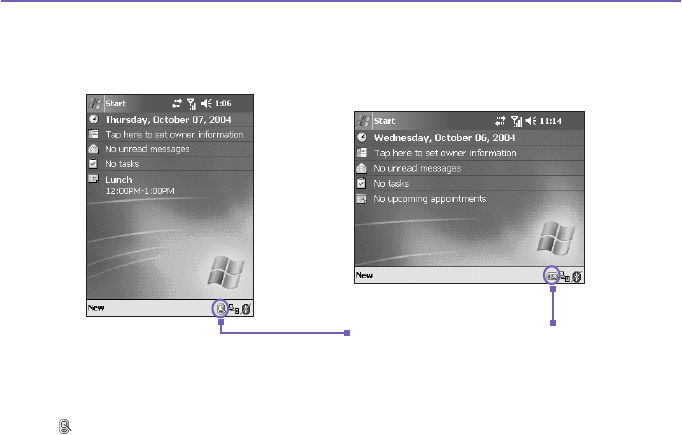
Pocket PC Phone User Manual18
Pocket PC Phone User Manual 19
Screen Orientation
To switch the orientation of your touch screen between the Portrait mode or the Landscape
mode, select the Orientation options by tapping the lower right Screen Orientation icon
, tap once for Landscape (right-handed), another one for Landscape(left-handed). Or,
alternatively, you can tap the Start menu > Settings > the System tab > Screen. The
Portrait mode allows you to get a better view or a better operation of certain programs on
your Pocket PC, while Landscape may be optimal for viewing longer text les.
For easier reading of text in programs that support ClearType, tap the ClearType tab, and
then select Enable ClearType. To increase readability or see more content by adjusting
the size of text in programs that support it, tap the Text Size tab. Move the slider to make
text larger or smaller.
Landscape Mode
Portrait Mode
Tap on this icon to change screen orientation.
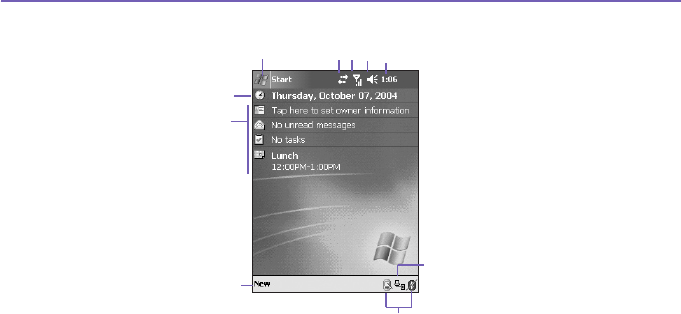
Pocket PC Phone User Manual20
Pocket PC Phone User Manual 21
The Today screen
1. Tap to bring up a menu list of programs.
2. Tap to view call status information.
3. Tap to view network status and options.
4. Tap to change volume or mute all sounds.
5. Tap and hold to change time format.
6. Tap to change date and time.
7. Your day-at-a-glance reminders. Tap to open the related program.
8. Tap to create a new item.
9. Tap to disconnect ActiveSync, or turn ON/OFF Bluetooth.
10. Tap to change screen orientation.
Note: To go back to the Today screen when you are using other programs, just tap the
Start menu > Today.
Note: To customize the Today screen display, including the background image, tap
the
Start menu
> Settings > the Personal tab > Today.
Please refer to Chapter 5 for more
information.
142 35
6
7
8
9
10
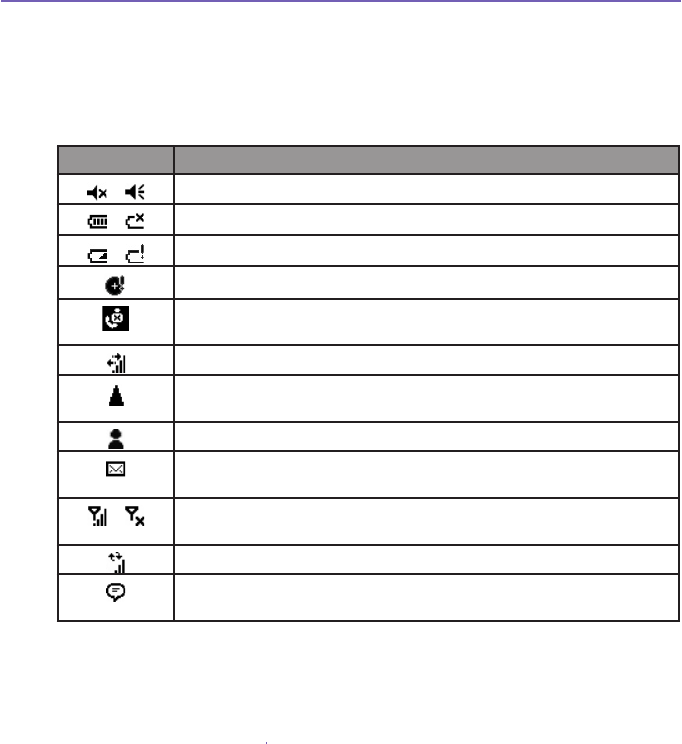
Pocket PC Phone User Manual20
Pocket PC Phone User Manual 21
Indicators
Your Pocket PC's status indicators are located at the top right of the Today screen. Some
common indicators are listed below. If you are not sure about the meaning of an indicator,
tap on it with your stylus and a dialog box will explain its function and allow you to change
the settings for that particular icon.
Indicators Meaning
/ Sounds are off / sounds are on.
/ Main battery with full strength/ No battery
/ Main battery low/ very low.
Backup battery is very low.
Indicates that Caller ID monitor program is not yet ready to receive
calls.
Data connection is active.
Indicates that your Pocket PC Phone is roaming in a different
network area.
Notication that one or more instant messages were received.
Notication that one or more mobile e-mail/text messages were
received.
/ Indicates the connection to your service provider/network operator is
on/off. (with signal strength)
Indicates that your Pocket PC Phone is synchronized with a PC.
Indicates that more notication icons need to be displayed. Tap the
icon to view all.

Pocket PC Phone User Manual22
Pocket PC Phone User Manual 23
Notications
Your Pocket PC Phone reminds you in a variety of ways when you have something to do or
when you have received an SMS message. For example, if you’ve set up an appointment
in Calendar, a task with a due date in Tasks, or an alarm in Clock, you will be notied in
any of the following ways:
n A message box appears on the screen.
n A sound, which you can specify, is played.
n A light ashes on your Pocket PC.
n The Pocket PC Phone vibrates.
To choose reminder types and sounds for your device, the Start menu > Settings > the
Personal tab > Sounds & Notications. The options you choose here apply throughout
the Pocket PC.
Pop-Up menus
Use pop-up menus to quickly perform an action on an item. To access a pop-up menu,
tap and hold the item that you want to perform the action on. When the menu appears,
tap the action you want to perform, or tap anywhere outside the menu to close it without
performing an action.
1. Tap and hold to display the pop-up menu.
2. Lift the stylus and tap the action you want.
3. Tap outside the menu to close it without performing an action.
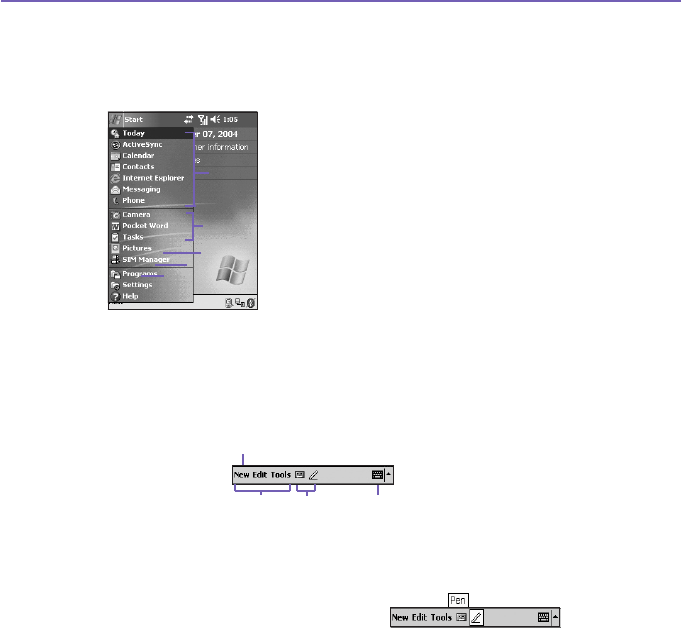
Pocket PC Phone User Manual22
Pocket PC Phone User Manual 23
Navigation bar
The navigation bar, located at the top of the screen, displays active programs and current
time, and enables you to switch between programs and close screens.
1. Tap to switch to a program.
2. Tap to switch to a recently used program.
3. Tap to see more programs.
4. Tap to change device settings.
5. Tap to see a Help topic for the current screen.
Command bar
Use the command bar at the bottom of the screen to perform tasks in programs. The
command bar includes menu names, buttons, and the Input Panel button.
1. To create a new item in the current program, tap New.
2. Tap to select menu commands.
3. Tap to select button commands.
4. Tap to display the input panel.
To see the name of a button, tap and hold the stylus on the button. Drag the stylus off the
button so that the command is not carried out.
1
2
3
4
5
1
234
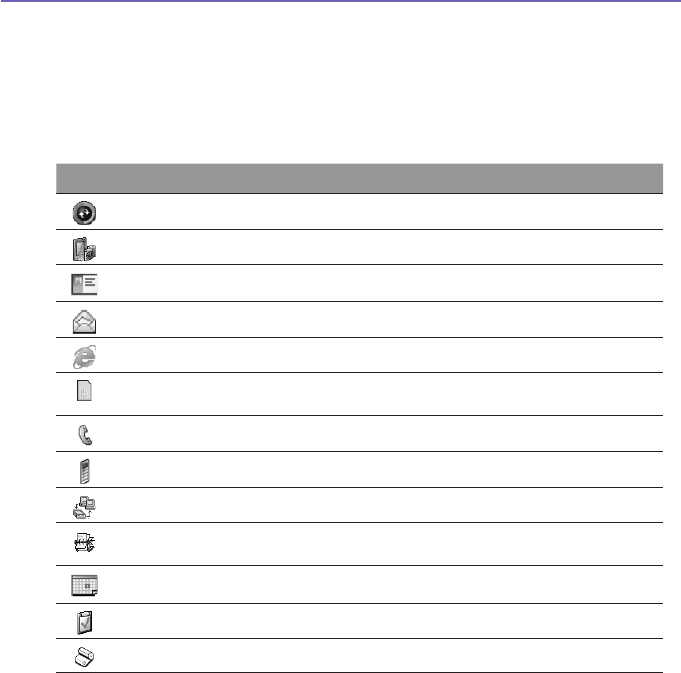
Pocket PC Phone User Manual24
Pocket PC Phone User Manual 25
Programs
You can switch from one program to another by selecting it from the Start menu.
To access a program, tap the Start menu > Programs, and then the program name. You
can also switch to some programs by pressing a program button on your device. For more
information about the Button settings, please see Chapter 5.
Icon Description
ActiveSync synchronizes information between your device and PC.
xBackup backs up your Pocket PC Phone les.
Contacts keeps track of your friends and colleagues.
Messaging sends and receives Email/SMS/MMS messages.
Pocket IE browses Web sites and downloads new programs and les.
SIM Tool Kit (STK) allows you to access information and other services offered by
your operator.
Phone makes/receives calls, and switches between calls.
Calculator performs basic arithmetic.
Wireless Modem uses your Pocket PC Phone as an external modem for a PC.
SIM Manager collects, organizes, and sorts the Contacts list stored on your SIM
card.
Calendar keeps track of your appointments and creates meeting requests.
Tasks keeps track of your tasks and reminds you of important events.
TrueFax sends and receives fax documents.
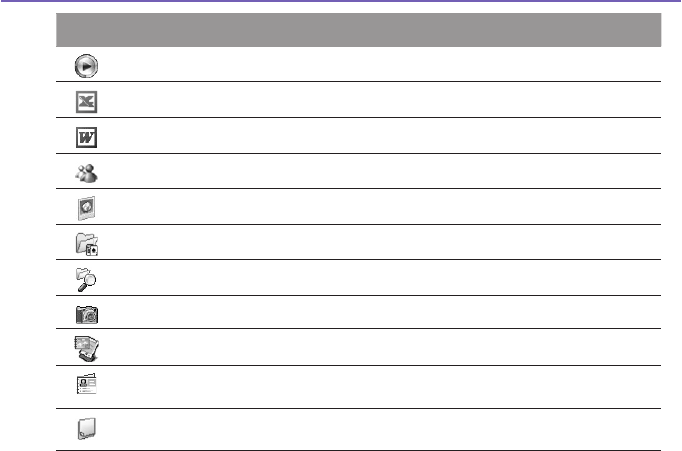
Pocket PC Phone User Manual24
Pocket PC Phone User Manual 25
Icon Description
Windows Media plays sound or video les.
Pocket Excel creates, views, and edits Excel workbooks.
Pocket Word creates, views, and edits MS-Word documents.
MSN Messenger sends and receives instant messages.
Pictures collects, organizes, and sorts .jpg picture les.
Games such as Jawbreaker and Solitaire are included.
File Explorer views all the les on your Pocket PC.
Camera snaps photos or shoots video clips.
Album collects, organizes, and sorts .JPG/.BMP/.GIF les.
Photo Contacts inputs the image les according to your Contacts list and sets up
Caller ID.
Notes creates handwritten or typed notes, drawings, and recordings.
2.2 Entering Information
You can enter information on your device in the following ways:
n Synchronizing: Using ActiveSync, exchange information between your PC and device.
(For more information on ActiveSync, see Chapter 4).
n Typing: Using the Input Panel or the keyboard on the bottom of your device, enter typed
text into the device. You can do this by tapping keys on the screen soft keyboard, by pressing
the keyboard, or by using the handwriting recognition software.
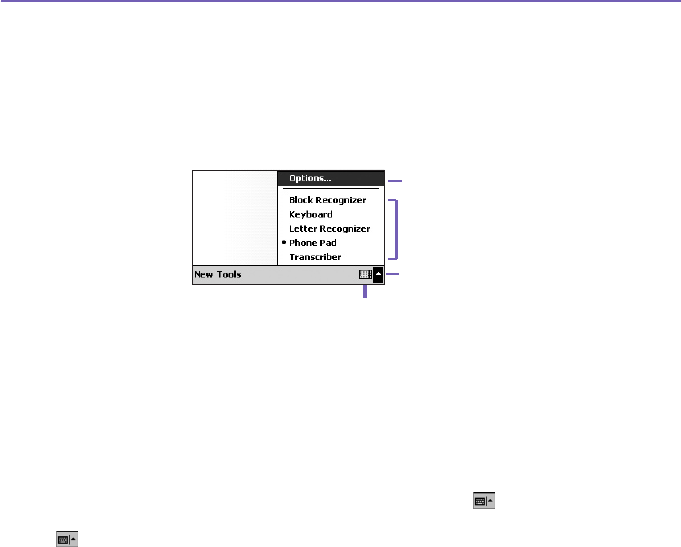
Pocket PC Phone User Manual26
Pocket PC Phone User Manual 27
n Writing: Using the stylus, write directly on the screen.
n Drawing: Using the stylus, draw directly on the screen.
n Recording: Create a stand-alone recording or embed a recording into a document or
note.
Using the Input Panel
Use the input panel to enter information in any program on your device. You can either
type using the soft Keyboard or write using Letter Recognizer, Block Recognizer,
Transcriber, or Phone Pad. In any case, the characters appear as typed text on the
screen.
Using the Soft Keyboard
To show or hide the input panel, tap the Input Panel button . To see your choices, tap
the arrow next to the Input Panel button. Tap the arrow next to the Input Panel button
, and then Keyboard.
1. To type lowercase letters, tap the keys with the stylus. To type a single uppercase
letter or symbol, tap the Shift key. To tap multiple uppercase letters or symbols, tap the
CAP key. You can also tap and hold the stylus on the key and drag up to type a single
uppercase letter.
Tap to open the selected
input panel
Tap to change
input panel options
Tap to select an
input panel
Tap to see the list
of input panels
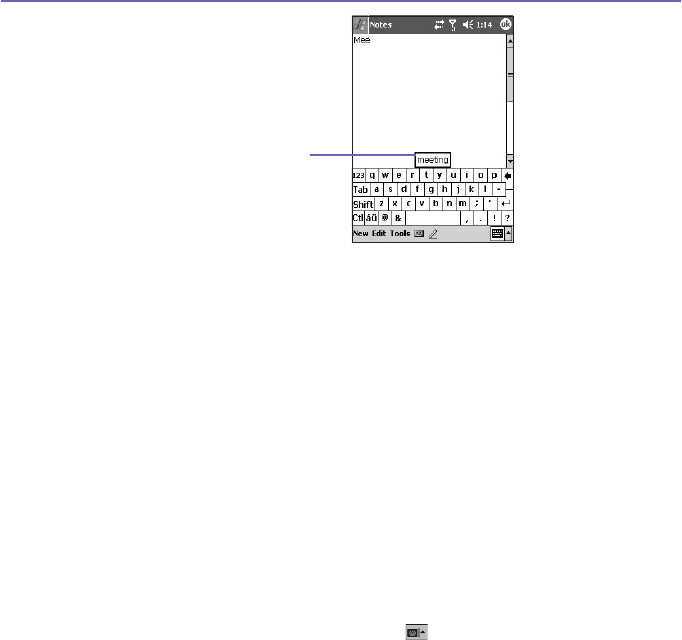
Pocket PC Phone User Manual26
Pocket PC Phone User Manual 27
2. To add a space, in addition to tapping the space bar, you can also tap and hold any key
and then drag the stylus to the right. To backspace one character, in stead of tapping
the backspace key, you can also tap and hold any key and then drag the stylus to the
left across at least two other characters.
3. To insert a carriage return, tap and hold the stylus anywhere on the keyboard and drag
down. When you use the input panel, your device anticipates the word you are typing
or writing and displays it above the input panel. When you tap the displayed word, it is
automatically inserted into your text at the insertion point. The more you use your device,
the more words it learns to anticipate.
Note: To change word suggestion options, such as the number of words suggested at one
time, tap the Start menu > Settings > the Personal tab > Input > the Word Completion
tab. For more information about Input settings, please see Chapter 5.
Using the Letter Recognizer
With the Letter Recognizer, you can write letters using the stylus just as you would on
paper.
1. Tap the arrow next to the Input Panel button , and then Letter Recognizer.
2. Write a letter in the box.
Tap to add the word if this
is the right one for you

Pocket PC Phone User Manual28
Pocket PC Phone User Manual 29
When you write a letter, it is converted to typed text that appears on the screen. For specic
instructions on using Letter Recognizer, with Letter Recognizer open, tap the question
mark next to the writing area.
Using the Block Recognizer
With the Block Recognizer, you can input character strokes using the stylus that are
similar to those used on other devices.
1. Tap the arrow next to the Input Panel button , and then Block Recognizer.
2. Write a letter in the box.
When you write a letter, it is converted to typed text that appears on the screen. For
specic instructions on using Block Recognizer, tap the question mark next to the
writing area.
Switching to Transcriber
With Transcriber, you can write anywhere on the screen using the stylus just as you would
write on paper. Unlike Letter Recognizer and Block Recognizer, you can write a sentence
or more. Pause and let Transcriber change the written characters to typed characters.
1. Tap the arrow next to the Input Panel button, and then Transcriber.
2. Write anywhere on the screen.
For specic instructions on using Transcriber, open Transcriber open, and tap the question
mark in the lower right-hand corner of the screen.
To punctuate in Transcriber:
1. Tap the keyboard button on the tool bar.
2. Tap the desired punctuation.
3. Tap the keyboard button again to hide the keyboard.

Pocket PC Phone User Manual28
Pocket PC Phone User Manual 29
To learn writing in Transcriber:
1. Tap on the tool bar.
2. A Letter Shapes Selector screen will appear:
n At the bottom of the screen, select the character you wish to explore.
n At the top of the screen, tap the picture of this character. It will slowly redraw, showing the
writing sequence.
n Select how often you write the character using that method.
When you nish the selecting all the letters, you can save these as a prole by tapping
File > Save, and enter a name for the prole.
Using Proles
Letter Shape Selector supports two proles: Master or Guest:
n Master is typically used by the Pocket PC's primary user. This prole is unaffected by any
Guest user settings.
n
Guest is for temporary device usage by another person.
Editing and selecting text
Each input program provides cursor keys to move through text and backspace so that you
can correct spelling, grammar or insert additional information. Alternatively, you can use
your stylus to make an insertion.
To select typed text, drag the stylus across the text you want to select. You can cut, copy,
and paste text by tapping and holding the selected words, and then tapping an editing
command on the pop-up menu, or by tapping the command on the Edit menu.
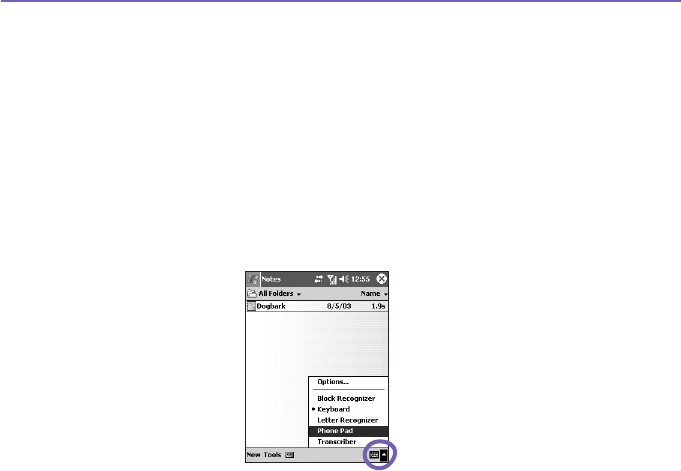
Pocket PC Phone User Manual30
Pocket PC Phone User Manual 31
2.3 Phone Pad
Phone Pad is a Soft Input Panel (SIP) application that provides a exible alternate input
method. With it, you can easily switch among three input modes (T9, Multi-Tap, and
Numeric) plus a Symbols menu, with greater convenience.
Using Phone Pad
Phone Pad can be activated at any time, except when in the Today screen or when in
Camera mode. To use Phone Pad, tap-and-hold the Keyboard icon which is shown near
the lower right corner of your screen, next to the triangular-shaped menu icon. Then
select Phone Pad from the menu to open the Phone Pad input panel.
Using T9 to Input Text
By default, Phone Pad is in T9 mode. It is the easiest and most convenient way to input
text in English. As you press alphanumeric buttons on the Phone Pad input panel, T9
tries to automatically match the letters you have selected with the most likely completed
word.
To type a word: Simply tap on the numeric keypad.
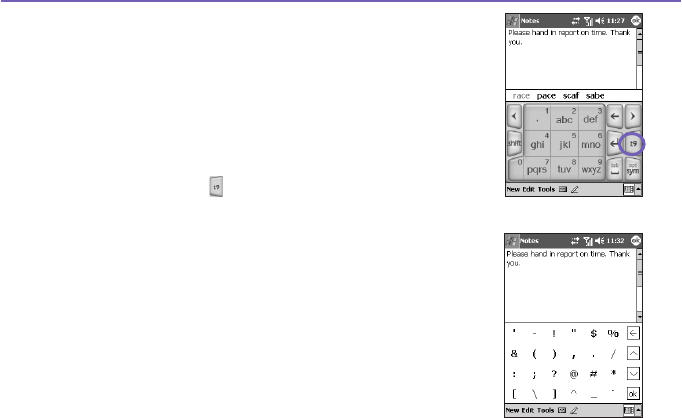
Pocket PC Phone User Manual30
Pocket PC Phone User Manual 31
To insert a word in the current application screen:
1. Tap any word in the wordlist.
2. Tap the space key.
3. Select a word and tap enter to insert the word.
To enter a number:
1. Tap and hold the number key on the Input panel.
2. Or, tap the button to switch to numeric mode.
Then tap the desired number(s).
To insert a tab: Tap and hold the space key.
To scroll the wordlist: Tap the left / right arrow keys.
To enter a capital: Tap the Shift key.
To add symbols:
1. Tap the 1 key to display the most frequently used
symbols on the screen.
2. Or, tap the sym key to see all the symbols. Then,
tap on the desired one(s) to enter to the wordlist
or application screen.
Using the Multi-Tap mode to Input Text
Unlike the T9 input mode, the Multi-Tap input mode will not search for all the possible
combinations of letters or try to guess at a partial word’s completion. You need to manually
enter all letters yourself to form words.
For example:
If you want to enter two consecutive “d” letters, tap the 3def key once, wait one second,
then tap again to enter the second “d.” Or, if you want to enter “e” into the Wordlist, you
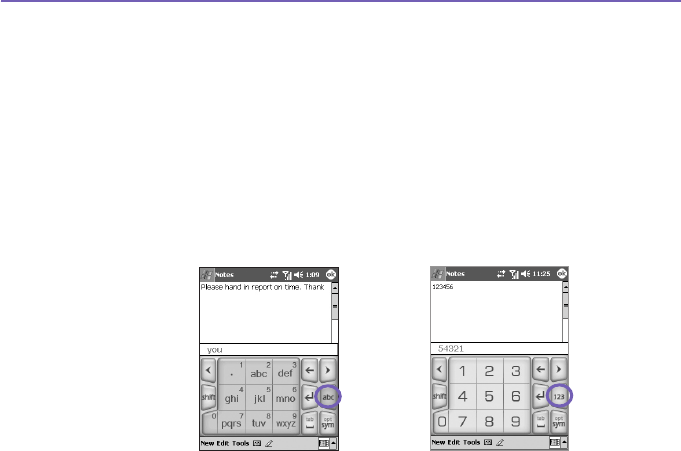
Pocket PC Phone User Manual32
Pocket PC Phone User Manual 33
must tap the 3def key twice quickly so that the “e” will be recognized, or tap three times
quickly if you wish to enter the letter “f.”
Entering Numbers
When 123 is indicated as the input mode, each time you press a number button on the
input panel, the associated number will display in the Wordlist panel.
After you have entered the desired number(s), tap the Enter button to insert the number(s)
on the screen. Or, if you wish to add a space after the number(s) is displayed, tap the
Space button instead.
Phone Pad Options
This feature lets you select various options for Phone Pad. You can invoke the Phone
Pad options screen in the following ways:
n Tap and hold the opt/sym button in Phone Pad.
n Tap the triangular icon in the extreme lower right corner of the screen. A menu
containing the Options command opens. Select Options from the menu.
Select Phone Pad as the input method, and then tap the Options button.
n Select Start Menu > Settings > Personal Tab > Input.
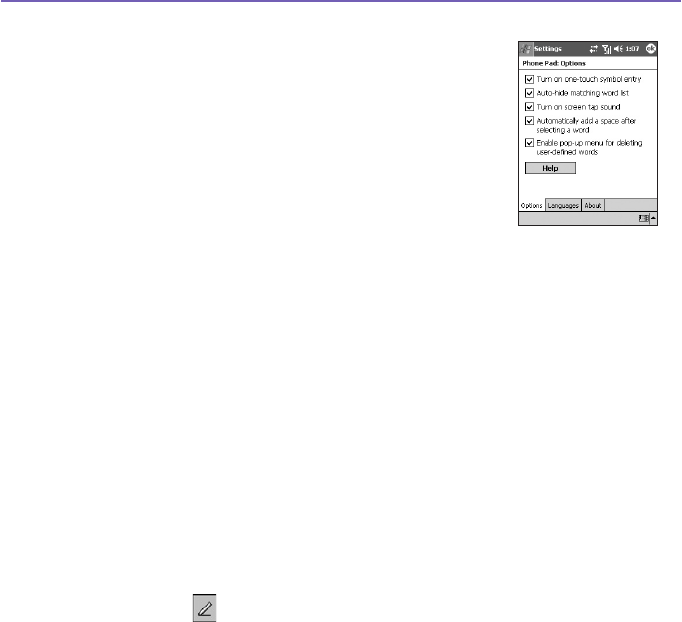
Pocket PC Phone User Manual32
Pocket PC Phone User Manual 33
The Phone Pad options available are:
n Turn on one-touch symbol entry
Check this box to select one symbol at a time.
n Auto-hide matching wordlist
Check this box to hide the word list after you
select a word.
n Turn on screen tap sound
Check this box to play a sound each time you tap
a key in Phone Pad.
n Automatically add a space after selecting a
word
Check this box to add a space automatically at
the end of every word, after entering a word.
n Enable pop-up menu for deleting user-dened
words
Check this option to display a pop-up menu
whenever you tap on a word that is in the user
database.
2.4 Writing on the Screen
In any program that accepts writing, such as Notes, and in the Notes tab in Calendar,
Contacts, and Tasks, you can use your stylus to write directly on the screen. Write as you
would on paper. You can edit and format what you have written and convert the information
into typed text at a later time.
Tap the pen button to switch to writing mode. This action displays lines on the screen
to help you write. Some programs that accept writing may not have the pen button. See
the manual for each particular program to nd out how to switch to writing mode.
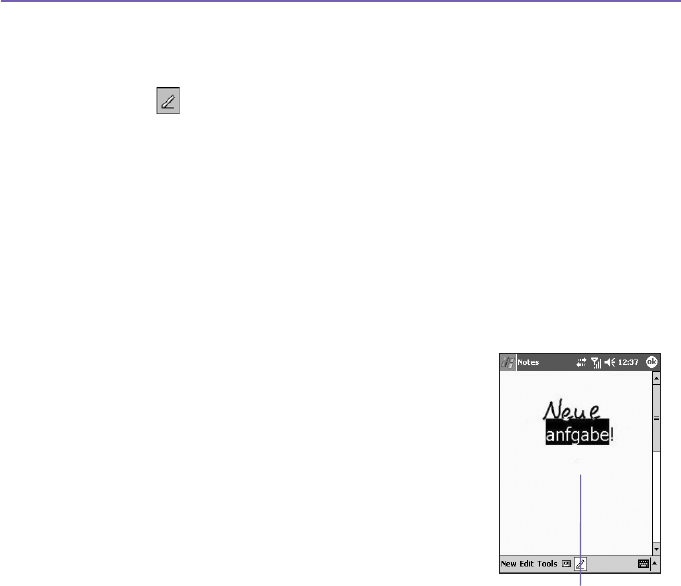
Pocket PC Phone User Manual34
Pocket PC Phone User Manual 35
Selecting writing
If you want to edit or format writing, select the text rst.
1. Tap again to exit the writing mode. This helps to select the written text more easily.
2. Tap and hold the stylus next to the text you want to select until the insertion point
appears.
3. Without lifting, drag the stylus across the text you want to select.
If you accidentally write on the screen, tap Edit, Undo, and try again.
You can cut, copy, and paste written text in the same way you work with typed text: tap
and hold the selected words, and then tap an editing command on the pop-up menu, or
tap the command on the Edit menu.
Converting writing into text:
1. On the writing note, tap Tools and Recognize from the
menu bar.
2. If you want to convert only certain words, select them
before tapping Recognize on the Tools menu (or tap
and hold the selected words and then tap Recognize on
the pop up menu).
If a word is not recognized, it will be left as writing. And if the
conversion is incorrect, you can select different words from a
list of alternates, or return to the original writing.
Tap and hold the incorrect word (tap one word at a time), then
tap Alternates from the pop-up menu. A menu with a list of
alternate words appears. Tap the word you want to use, or
tap the writing at the top of the menu to return to the original
writing.
The writing is
converted into
typed text

Pocket PC Phone User Manual34
Pocket PC Phone User Manual 35
Tips for good recognition:
1. Write neatly.
2. Write on the lines and draw descanters below the line. Write the cross of the “t” and
apostrophes below the top line so that they are not confused with the word above. Write
periods and commas above the bottom line.
3. For better recognition, use a zoom level of 150% or higher by tapping Tools > Zoom to
change the zoom level.
4. Write the letters of a word closely and leave big gaps between words so that the device
can easily tell where words begin and end.
5. Hyphenated words, foreign words that use special characters such as accents, and some
punctuation cannot be converted.
If you edit or add to a word after attempting to recognize it, the new writing will not be
included if you attempt to recognize it again.
2.5 Drawing on the Screen
You can draw on the screen in the same way that you write on the screen. The difference
between writing and drawing on the screen is how you select items and how they can be
edited. For example, selected drawings can be re-sized, while writing cannot.
To create a drawing:
Cross three ruled lines on your rst stroke. A drawing box appears. Subsequent strokes
in, or touching, the drawing box become part of the drawing. Drawings that do not cross
three ruled lines will be treated as writing.
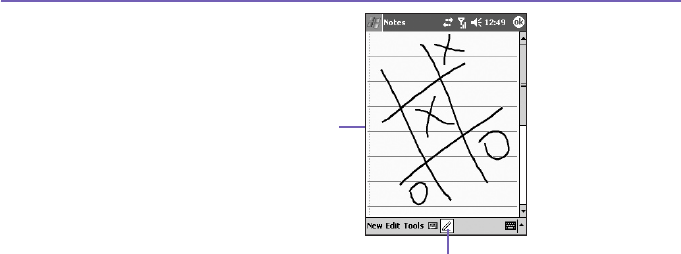
Pocket PC Phone User Manual36
Pocket PC Phone User Manual 37
To select a drawing
If you want to edit or format a drawing, you must select it rst.
1. Tap and hold the stylus on the drawing until the selection handle appears. To select multiple
drawings, deselect the pen button and then drag to select the drawings you want.
2. You can cut, copy, and paste selected drawings by tapping and holding the selected drawing
and then tapping an editing command on the pop up menu, or by tapping the command on
the Edit menu. To re-size a drawing, make sure the Pen button is not selected, and drag
a selection handle.
To change the zoom level so it is easier to work or view your drawing, tap Tools and then
select a zoom level.
2.6 Recording a Message
In any program where you can write or draw on the screen, you can also quickly capture
thoughts, reminders, and phone numbers by recording a message. In Calendar, Tasks,
and Contacts, you can include a recording in the Notes tab.
The drawing box indicates
the boundaries of the
drawing
Pen button
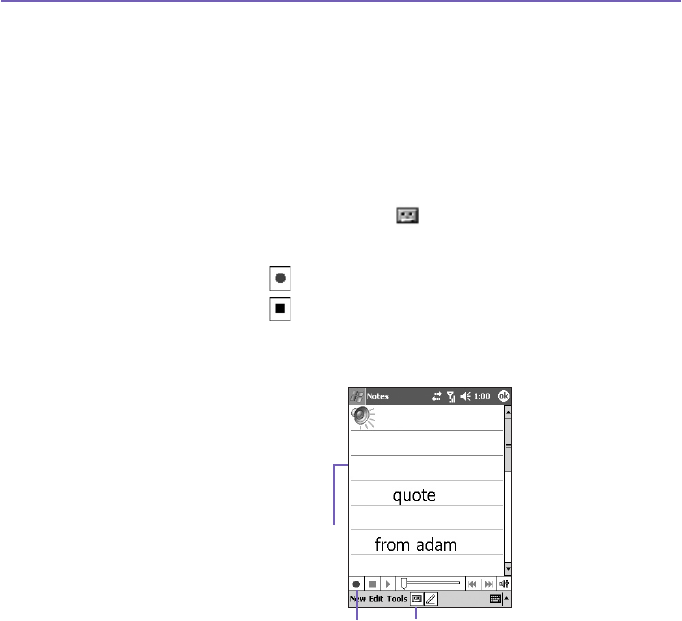
Pocket PC Phone User Manual36
Pocket PC Phone User Manual 37
In the Notes program, you can either create a stand-alone recording or include a recording
in a written note. If you want to include the recording in a note, open the note rst.
In the Messaging program, you can also add a recording to an E-mail message.
To create a recording:
1.
To add a recording to a note, open the note before recording.
Tap the Start menu > Programs
> Notes.
2.
If there is no Record/Playback toolbar, tap
.
3. Hold your device’s microphone near your mouth or another sound source.
4. To start recording, tap . A beep will sound.
5. To stop recording, tap . Two beeps will sound. The new recording appears in the note
list or as an embedded icon.
6. To play a recording, tap in the open note or tap the recording in the note list.
Tap to show or hide
the Recording tool bar
Tap to begin recording
Indicates an embedded
recording

Pocket PC Phone User Manual38
Pocket PC Phone User Manual 39
You can also invoke the
Record/Playback toolbar
by pressing the Record button, which
is the rst button from the top on the left side of your Pocket PC.
To quickly create a recording, hold down the Record button. When you hear the beep,
begin your recording. Release the button when you are nished.
The new recording is stored in the open note, or as a stand-alone recording, if no note
is opened.
Pulse Code Modulation (PCM) provides slightly better sound quality. However, PCM
recordings may take up to 50 times more storage space than Mobile Voice recordings.
PCM cannot be used to create recordings that are embedded in notes.
Change recording formats
In the note list, tap Tools > Options > the Global Input Options link (at the bottom of
the page).
Mobile Voice is a 2.4 KB audio codec (compressor/decompressor). It is the recommended
format because it provides good voice recording and takes up far less storage space than
PCM.
2.7 Finding Information
The Find feature on your Pocket PC Phone helps you quickly locate the information you
need.
1. Tap the Start menu > Programs > Find.
2. In Find, enter the le name, word, or other information you want to search for. If you have
looked for this item before, tap the Find arrow and select the item from the list.
3. To help narrow your search, select a data type under Type.

Pocket PC Phone User Manual38
Pocket PC Phone User Manual 39
4. Tap Go. The My Documents folder and sub-folders are searched.
5. In the Results list, tap the item you want to open.
To quickly nd information that is taking up storage space on your device, select Larger
than 64 KB in Type.

Pocket PC Phone User Manual40

Chapter 3
Using Your Pocket PC Phone
3.1 About Your Pocket PC Phone
3.2 Making a Call
3.3 Smart Dialing
3.4 Receiving a Call
3.5 In-Call Options
3.6 Contacts Information
3.7 Photo Contacts
3.8 Additional Dialing Information
3.9 Securing Your Pocket PC Phone
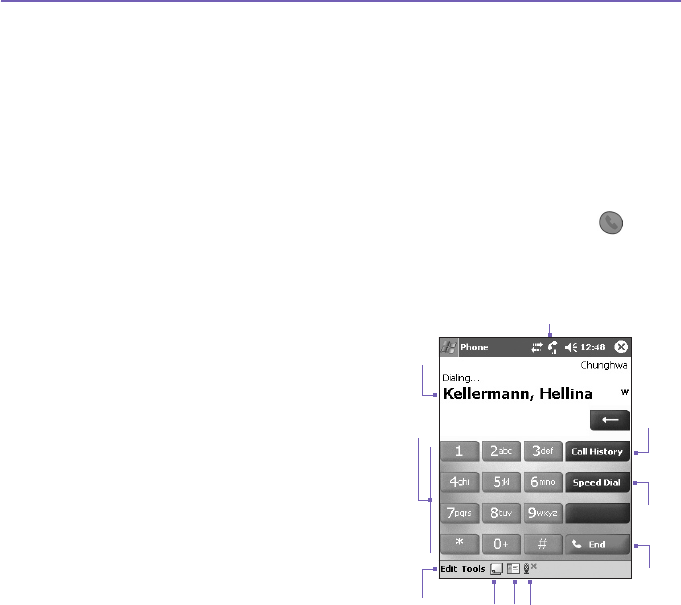
Pocket PC Phone User Manual42
Pocket PC Phone User Manual 43
3.1 About Your Pocket PC Phone
Like a standard mobile phone, you can use your Pocket PC Phone to keep track of
calls and send SMS messages. You can also take notes while talking, dialing directly
from Contacts, and easily transfer contacts between your SIM card and the RAM of your
device.
The phone dialer screen
To access the Phone Dialer Screen, tap the Start menu
>
Phone, or press on your
Pocket PC Phone . From this screen, you can access Call History, Speed Dial, and Phone
Setting. Signal status information and icons that tell you about your call include:
1. Indicates the strength of the signal.
2. The contact name of the number you are
dialing is displayed here.
3. Touchscreen keypad.
4. Clear, copy, or paste numbers.
5. Tap to make a note during a call.
6. Tap to select your contact from the
Contacts list.
7. Tap to mute a call.
8. Tap to end a call.
9. Stores frequently-called numbers.
10. View all history including received, dialed
and missed calls.
2
3
7
9
10
56
1
4
8

Pocket PC Phone User Manual42
Pocket PC Phone User Manual 43
The navigation pad and dialing
1. Phone Dialer Screen: Press to activate the Phone Dialer Screen.
Take a Call: Press to take an incoming call.
Speakerphone: During a call, press and hold to turn the speakerphone ON or OFF.
Dial: Press to dial a phone number.
2. Scroll Up: Press to scroll up through a list, or enter Call history.
3. End Call: Press to end a call or to end a GPRS connection.
4. Call History: After launching the Phone Dialer Screen, press to enter the Call
History feature.
5. Scroll Down: Press to scroll down through a list.
6. Action Key: Press to select a menu item, or to enter Speed Dial.
7. Speed Dial: After launching the Phone Dialer Screen, press to enter the Speed Dial
feature.
23
5
6
1
4
7

Pocket PC Phone User Manual44
Pocket PC Phone User Manual 45
Entering your PIN
Most SIM cards are preset with a PIN (Personal Identication Number). This PIN is
provided by your operator, which you need to enter whenever you use your device. (For
more information on installing your SIM card into your Pocket PC Phone , please see the
illustrations in the Quick Start Guide.)
1. Enter the preset PIN assigned by your operator.
2. Tap the Enter button.
If your PIN is entered incorrectly three times, the SIM card will be blocked. If this happens,
you can unblock it with the PIN Unblocking Key (PUK) from your operator.
Checking your connection
By default, your Pocket PC Phone will automatically connect to the your operator network
once you have inserted a SIM card and entered the required PIN code. The icon indicates
that you are connected to an operator network, or an afliated provider. A full strength signal
is indicated by . As the strength of the signal diminishes, so will the number of vertical
bars in the icon, with no bars indicating no signal.
LEGAL NOTICE: In many countries you are required by law to turn off your phone on
board an aircraft. Turning off the power of your Pocket PC Phone doesn't turn off the
phone function. You must turn on the Flight Mode in order to disconnect the connection
to the wireless network.

Pocket PC Phone User Manual44
Pocket PC Phone User Manual 45
Turning on the Flight Mode
To turn OFF your wireless connection to an active network, you can switch your phone
connection mode to Flight mode. You can turn the Flight Mode On or Off while keeping
your Pocket PC Phone turned ON.
1. While using any program on your Pocket PC Phone , tap in the title bar at the top of
the phone’s display.
2. Tap the Turn on ight mode or Turn off ight mode option in the pop-up dialog box.
3. Select the Turn off ight mode to receive calls.
You can use any programs on your device during a call. To quickly switch back to the
Phone Dialer Screen, tap , or tap
the Start menu
> Phone.
Adjusting the phone volume:
1. During a call, tap or press the volume buttons on the side of your device.
2. You can select to adjust the phone volume (ring) or device volume (notication
levels and MP3) on the pop-up menu.
3. If you select Vibrate mode, will appear in the title bar at the top of the phone
display.
4. Turn off the volume by choosing the Off option.
To adjust the conversation phone volume, you must do it during a call. Adjusting the volume
at another time will affect the ring, notication, and MP3 sound levels.
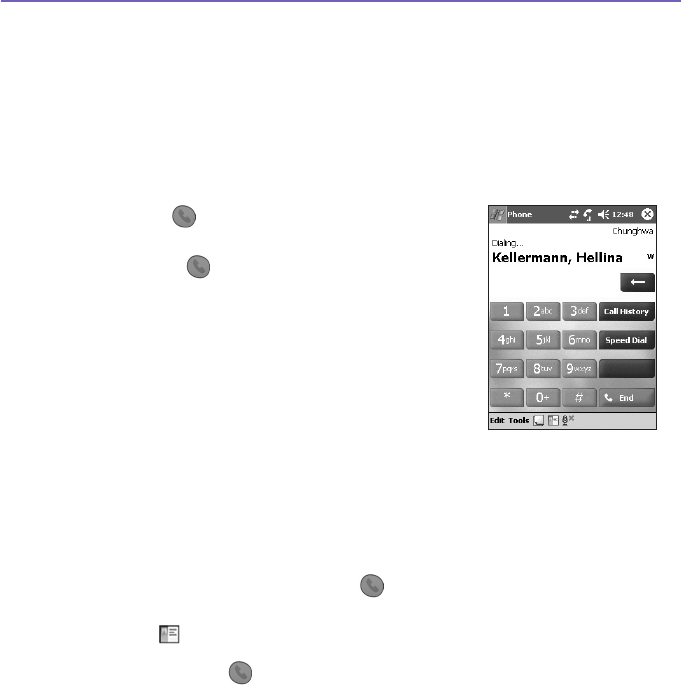
Pocket PC Phone User Manual46
Pocket PC Phone User Manual 47
3.2 Making a Call
With your Pocket PC Phone , you can make a call from
the Dialer, Contacts, Speed Dial, Call History, and SIM
Manager.
Making a call from the Dialer
The most direct method is by using the Phone keypad.
1. Press to bring up the dialer screen.
2. Tap the number on the keypad, then tap the Talk button
or press .
Backspacing and deleting
If you tap a wrong number, you can back space by tapping
the back arrow key to erase individual numbers one at a
time. You can also delete all the numbers in the window by
tapping Edit > Clear from the Dialer screen.
Making a call from Contacts
You can make a call from Contacts in the following
ways:
n Press the Contacts button in the upper left corner of
your Pocket PC Phone .
n Find the contact, and then press the button twice
(Once to send to the dialer screen and once to call).
n Tap at the bottom of the Dialer screen. This will
invoke Contacts. Select a contact in the contact list,
and then press twice.
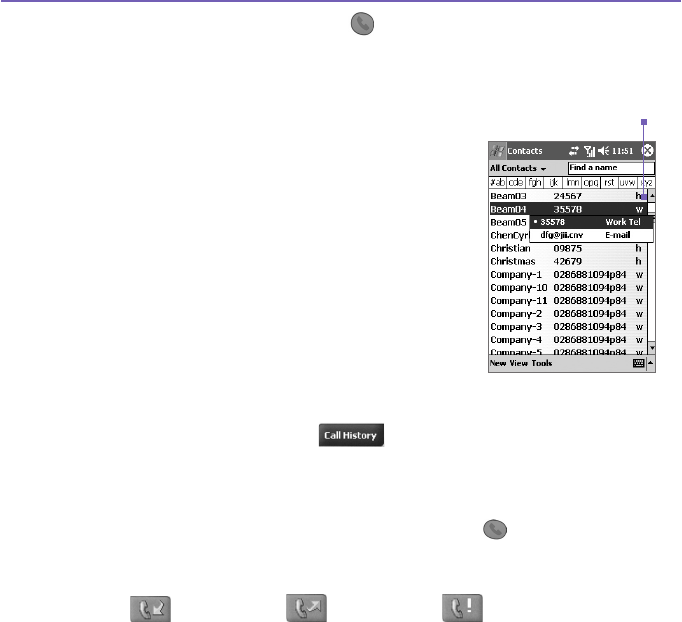
Pocket PC Phone User Manual46
Pocket PC Phone User Manual 47
A pop-up number right after pressing the will call the Work Tel by default. However,
you can customize it so that the mobile number or E-mail is displayed instead.
n In the Contacts list, tap the w in the right column
next to the contact you want to customize. A pop-up
menu will display the phone numbers and E-mail
addresses for this contact with a dot next to the
priority number.
n In the pop-up menu select a priority. If you selected a
mobile number, m should now be in the right column
next to the contact.
n When pressing the Left or Right button on the
navigation pad, the number of the selected contact
on the screen will change, displaying the mobile
number, work number, or E-mail in turn.
Making a call from Call History:
1. In the Dialer screen mode, tap , or just press the Right button on the navigation
pad.
2. Find the call details by rst selecting the category it is led under. For example, if it is in All
calls, select All calls from the drop down menu in the top-left corner.
3. Use the navigation pad to nd the number and then tap or the icon to the left of the
number you wish to call.
Call History icons include:
Incoming calls. Outgoing calls. Missed calls.
Tap the w here to pop-up all the
phone numbers and E-mails for
this contact

Pocket PC Phone User Manual48
Pocket PC Phone User Manual 49
Making a call from Speed Dial
Create Speed Dial to call frequently-used numbers with a single tap. The number must
already exist in Contacts before you can create a Speed Dial entry.
1. From the Phone keypad, tap > New.
2. Tap the desired contact name and number.
3. In the Location eld, tap the Up/Down arrows to select an available location to assign as
the new Speed Dial entry. (The rst Speed Dial location is reserved for your voice mail).
By memorizing the position in the Speed Dial list of a number, you can dial the number by
pressing and holding its position number. By default the Location function will give you the
next available position in the Speed Dial setting screen. If you want to put a number in a
position that is already occupied, the new number will replace the number already there.
Tips for using Speed Dial
To create a Speed Dial entry from Contacts, tap and hold the contact name > Add to
Speed Dial > Up/Down arrows to select an available location to assign as the new speed
dial entry.
To delete a Speed Dial entry, go to the Speed Dial list, tap and hold the contact name in
the box to the right of the assigned speed dial number, and then tap Delete.
Checking your Voice Mail
By default, the rst Speed Dial location is your voice mailbox. When you insert your SIM
card into your Pocket PC Phone, it will automatically detect and set, by default, the voice
mailbox number of your service provider.

Pocket PC Phone User Manual48
Pocket PC Phone User Manual 49
On the Phone Dialer screen, tap or press the Left button on the navigation pad,
select Voice Mail, and then press .
Making a call from SIM Manager
SIM Manager allows you to view the contents of your SIM card, transfer contacts to
Contacts on your Pocket PC Phone , and make a call from SIM.
1. Tap
the Start menu
> Programs > SIM Manager. Wait for your SIM card contents to
load.
2. Tap and hold the name or phone number of the person you wish to call, and then select
Call from the pop-up menu.
3.3 Smart Dialing
Smart Dialing is an application that makes it easy for you to dial a phone number on your
Pocket PC Phone Edition. Smart Dialing searches the Phonebook entries in both the SIM
card and Pocket Contacts, as well as numbers in Call History (Incoming, Outgoing, or
Missed). As soon as you start entering numbers, Smart Dialing starts looking for matches,
and lists them in the Smart Dialing window in the upper left area of your screen. Both
Portrait and Landscape orientations are supported.
Starting Smart Dialing
Smart Dialing starts running along with Microsoft Phone Dialer automatically, as soon as
you start dialing a number.
To open the Phone Dialer screen,
n Select Phone from the Start Menu,
n Or press the Talk button.
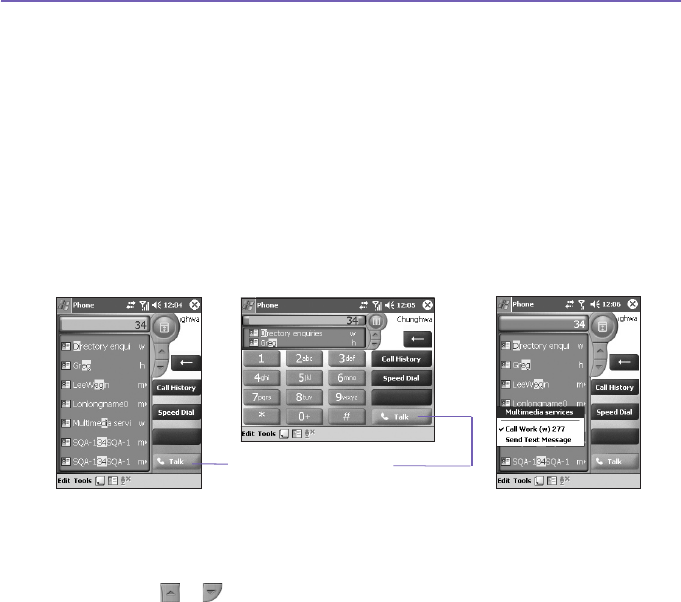
Pocket PC Phone User Manual50
Pocket PC Phone User Manual 51
Tap the rst digit of the number you want to dial. The Smart Dialing window will then
appear in the upper left area of the Phone screen.
How the matching numbers works
Smart Dialing starts looking for numbers that match the sequence you have entered
thus far. It looks for matches in your SIM card, Pocket Contacts, and Call History.
Matching is performed according to both the number and the letter associated with the
selected button on the keypad.
Each time you tap an additional digit or delete a digit, the search is renewed and the
result is re-displayed. The list may include phone numbers and/or Contact names
associated with matching number sequences.
Making a call or sending a text message
To browse the result after you tap in some digits,
n Tap or , located at right side of the result list.
n Or press up/down buttons on navigation pad.
The selected contact is higihlighted in gray.
Tap the Talk button to dial

Pocket PC Phone User Manual50
Pocket PC Phone User Manual 51
To see more matched contacts, tap .
To call selected contact,
n Tap Talk button on the Phone pad.
n Or press Talk/Send button.
If a contact number has display, this contact has more than one phone numbers. To call
selected contact with a different phone number,
n Tap and hold the selected contact to display a pop-up menu, then tap on the
desire phone number to call.
n Or press Left/Right buttons on navigation pad to select desire phone
number, then tap Talk button on the Phone pad or press Talk/Send button to
call.
To send a text message to the selected contact, tap and hold the selected contact to
display a pop-up menu, then tap on the Send Text Message.
To view or edit selected contact's detailed information (only contacts stored in Contacts),
n Tap and hold the selected contact to display a pop-up menu, then tap on the
contact's name.
n Or press Action button.
Smart Dialing Options
This feature lets you select various options for Smart Dialing. You can invoke the Smart
Dialing Options screen by selecting Tools > Smart Dialing Options from the Phone
screen.
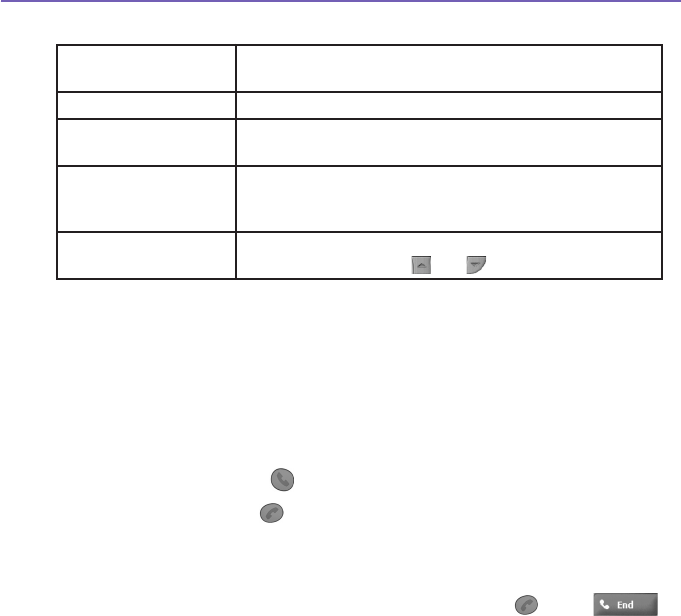
Pocket PC Phone User Manual52
Pocket PC Phone User Manual 53
Here are the list of Smart Dialing options:
Enable Smart Dialing Check this box to automatically enable Smart Dialing
each time you make a call.
Enable drag-scroll Check this box to scroll the list of matched items.
Enable double-click for
dialing
Check this box to call a number from the list by tapping
twice on it.
Display numbers in
standard format
Check this box to display numbers formatted with
standard characters such as hyphen, parantheses, and
space.
Scroll unit Choose to scroll by One line, Half page, or One page.
This option only affects and buttons.
3.4 Receiving a call
Answering an incoming call
When you receive a phone call, a message will appear, giving you an option to either
answer or ignore the incoming call.
1. Tap Answer, or press .
2. Tap Ignore or press to silence the phone and reject the call. This may route the call
to your voice mail, depending on your service provider.
Ending a call
Once an incoming or outgoing call is in progress, you can press , or tap on
the Dialer screen to hang up.
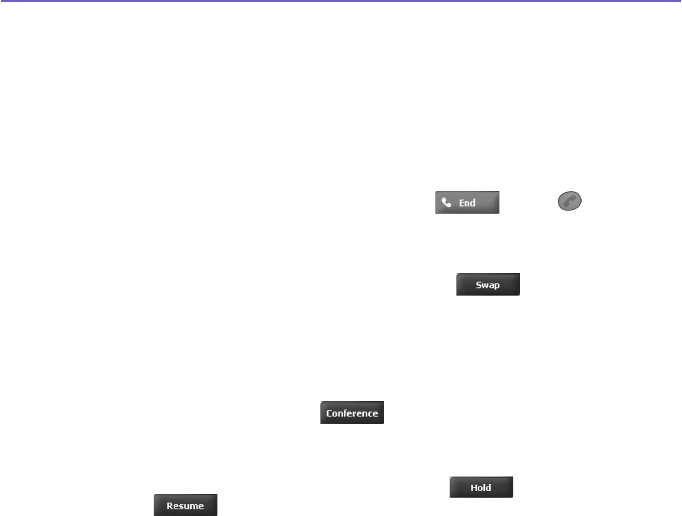
Pocket PC Phone User Manual52
Pocket PC Phone User Manual 53
3.5 In-Call Options
Putting a call on hold
Your Pocket PC Phone noties you when you have another incoming call and gives you the
choice of rejecting or accepting the call. If you accept, you can choose to switch between
the two callers or set up a conference call between all three parties.
1. Tap Answer to take the 2nd call and put the 1st one on hold.
2. To end the 2nd call and go back to the 1st one, tap or press .
Swapping between calls
You can choose to switch between 2 callers by pressing .
Setting up conference calls:
1. Either put a call on hold, dial a 2nd number and wait for it to be picked up. Or, accept a 2nd
incoming call when you already have one in progress.
2. In the screen that appears tap .
3. If the conference connection is successful, the word Conference will appear at the top of
the Phone Dialer screen.
4. To add additional people to your conference call, tap enter the number, and then
tap to return and continue.
Making notes during a call
Regardless of whether you call from the Phone Dialer, Contacts, Call History, Speed
Dial or SIM Manager, you can take notes during a call. After you have nished the note,
it will be saved as an attachment to your call in one of the Call History folders.
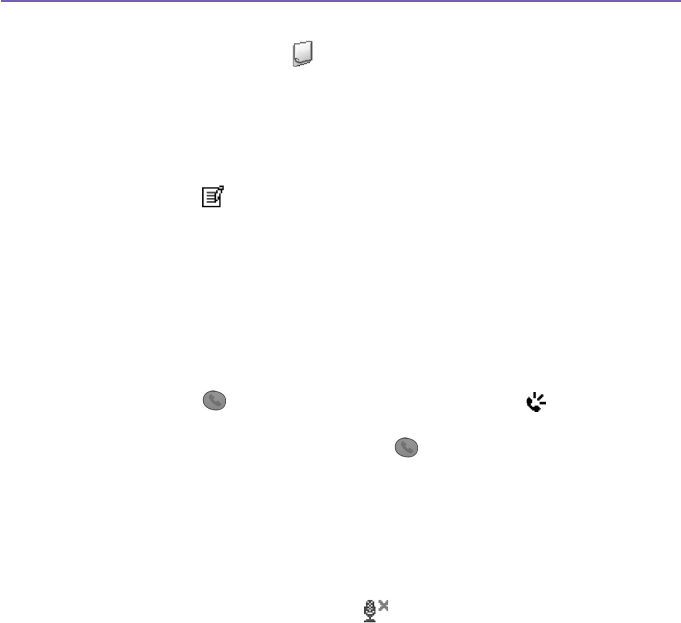
Pocket PC Phone User Manual54
Pocket PC Phone User Manual 55
Writing a note:
1. During a call, just tap the icon at the bottom of the screen.
2. Use any of the input methods to record your note and then tap OK. You can nish your
note during or after the call.
Viewing a note:
1. In Call History list, tap and hold the desired number, then tap View Note in the pop-up
menu. The icon indicates a note.
2. Or, go to Notes, and then tap the name of the le in the list. (For more information, see
Chapter 2).
Turning on the speakerphone
Your device has a speakerphone allowing you to talk hands-free or let other people listen
to the conversation.
1. Wait until the phone is ringing.
2. Hold down until the speakerphone comes ON and the icon appears in the status
bar.
3. To turn OFF the speakerphone hold down again.
WARNING: To avoid damage to your hearing, do not leave your Pocket PC Phone on
speakerphone mode and hold it against your ear.
Muting a call
You can mute your microphone during a call so that you can hear the caller without being
heard. From the Phone Dialer keypad, tap to mute or un-mute a call.

Pocket PC Phone User Manual54
Pocket PC Phone User Manual 55
3.6 Contacts Information
Contacts can be imported in the following ways:
n From your SIM card: Use your SIM card on your Pocket PC Phone and another device;
while using the other device you create one or more new contacts on the SIM card.
n From your Call History: New contact numbers can be found in incoming or missed calls.
Why import contacts?
n Backup your SIM numbers to your Pocket PC Phone .
n When setting Speed Dial numbers, it must be based on those contacts in Contacts, not
on the SIM card.
n Creating contacts in Contacts creates more detailed records.
n While using Photo Contacts, data of contacts fully mirror those in Contacts.
SIM Manager
Creating a SIM contact:
1. To open SIM Manager, tap
the Start menu
> Programs > SIM Manager. Wait for your SIM
card contents to load.
2. After the SIM contents have loaded, tap New.
3. Fill in the Name and Phone details, tap Add.
Transferring contacts from SIM to Contacts:
On SIM Manager, tap Tools > Select All > Save to Contacts. Press and hold the center
of the navigation pad when a contact has been selected, or tap and hold a contact from
the list. Select Save to Contacts from the pop-up menu.
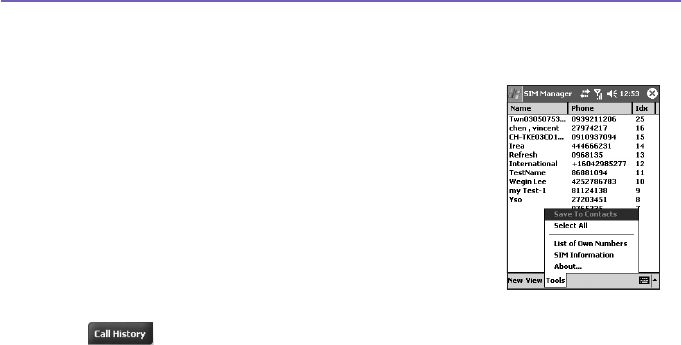
Pocket PC Phone User Manual56
Pocket PC Phone User Manual 57
Saving your own numbers
You can choose to save your personal phone numbers in a separate screen in SIM
Manager.
1. Tap
the Start menu
> Programs > SIM Manager >
Tools > List of Own Numbers.
2. Add a number to the screen, and then tap OK.
Call History
Tap on the phone screen to view the call history list.
Adding a Phone number from Call History to Contacts:
1. Find the call details you want to add.
2. Press and hold the stylus or press and hold the center button of navigation pad. Select
Save to Contacts in the pop-up menu that appears.
3. In the Save to Contacts screen, add additional contact details and press the navigation
pad center or tap OK.
The call details in the Call History will then be amended and displayed under the name,
not the phone number, when the contact is created
.
Viewing calls details
Tap in the top left corner of the screen and then select a category from the drop down
menu. Calls are categorized as follows:

Pocket PC Phone User Manual56
Pocket PC Phone User Manual 57
n All Calls: Displays all calls made to and from the phone in chronological order.
n Missed : Displays calls that were not answered.
n Outgoing : Displays calls made from the phone.
n Incoming : Displays calls made to the phone.
n By Caller: List calls alphabetically by caller.
Viewing call duration:
Go to Call History, nd the call, and then tap once on the time called.
Deleting individual calls:
Tap and hold the stylus on the call to be deleted. Select delete from the pop-up menu.
Deleting all calls:
Tap Tools > Delete all Calls.
Limiting the size of Call History:
Tap > Tools > Call Timers and then the box under Delete call history items
older than. In the drop-down menu select a time period, then tap OK.
3.7 Photo Contacts
Photo Contacts make your Pocket PC Phone more fun and practical. It allows you to as-
sign still or animated photos to the entries in your Contacts. When a person calls you (for
whom you have previously assigned a photo in Photo Contacts), that photo will appear
on your Pocket PC Phone ’s incoming call screen. Use the rich set of features to get the
photos displayed with the size, position, and animated template you want.

Pocket PC Phone User Manual58
Pocket PC Phone User Manual 59
Creating a new photo contact:
1. Tap
the Start menu
> Programs > Photo Contacts.
2. Select a contact from the list, or create a new one by tapping Edit > New. Photo Contacts
here fully mirror those in Contacts.
3. Tap Edit > Assign Photo...
4. Tap the eld next to Type to select the type of les you want listed, i.e., jpeg, bmp, gif or
all > next to Find in: to select the location of a le. You can use JPEG, BMP, still GIF, or
animated GIF les for your Photo Contacts.
5. Tap a picture le, then OK, and OK again until you return to the Photo Contacts screen.
You can see the photo at the bottom of the screen.
To preview and adjust settings:
In step 5 above, after you tap OK once you will arrive at the preview
and display settings screen. In Display Settings you can:
1. Add extra style by assigning a template to the photo A few sample Photo Contacts
templates (animated graphical templates that can frame your assigned photos) are
included in your Pocket PC Phone 's local storage in the \My Documents\Templates
folder.
2. Choose how you want the photo to t to the window.
3. Enlarge the photo if it is smaller than the window.
4. Choose a size and position for the picture.
5. View all of these changes by tapping Preview.
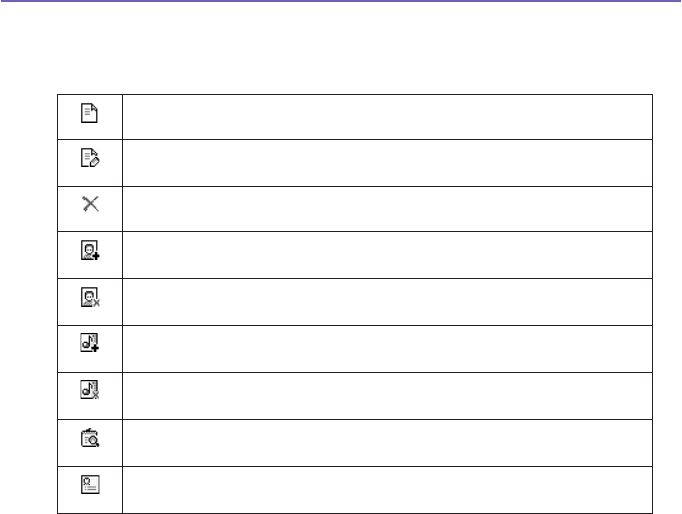
Pocket PC Phone User Manual58
Pocket PC Phone User Manual 59
Toolbar Icons
The Toolbar provides a convenient way for you to select frequently-used commands. From
left to right, the functions of the icons on the Toolbar are:
Create a new Contact entry (same as New... on the Edit Menu).
Modify data for the selected Contact entry (same as Edit... on the Edit
Menu).
Delete the selected Contact entry (same as Delete on the Edit Menu).
Assign a Photo ID to a Contact entry (same as Assign Photo... on the
Edit Menu).
Remove a Photo ID assignment (same as Unassign Photo on the Edit
Menu).
Assign a ring tone to a Contact entry (same as Assign Ringtone... on
the Edit Menu).
Remove a ring tone assignment (same as Unassign Ringtone on the
Edit Menu).
Preview the current Photo/template assignment (same as Preview... on
the View Menu).
Invokes “Detailed View” for the current entry (same as Properties... on
the View Menu).
To assign a photo from the camera:
1. Tap
the Start menu
> Programs > Photo Contacts.
2. Select a contact from the list, or create a new one by tapping Edit, then New. Photo Contacts
here fully mirror those in Contacts.
3. Tap Edit then Assign Photo from Camera.
4. After you take the picture, you will be returned to the Display Settings and Preview
screen.

Pocket PC Phone User Manual60
Pocket PC Phone User Manual 61
To unassign a photo:
1. Tap
the Start menu
> Programs > Photo Contacts.
2. Select an existing contact entry that you want to remove.
3. Tap Edit > then Unassign Photo. Tap yes in the pop-up box.
To view your contacts by photo:
1. Tap
the Start menu
> Programs > Photo Contacts.
2. Tap the Dialer View icon. Or, tap View > Photo Dialer View.
In the Photo Dialer view mode, the View Menu contains three additional commands
that allow you to specify the size of the thumbnail images: Large Thumbnails, Normal
Thumbnails and Small Thumbnails. You can enter the Detailed View of Photo Contact
using any of these methods:
n Select the desired Contact entry > Properties... on the View Menu.
n Select the desired Contact entry > the Properties icon on the Toolbar.
n Select the desired Contact entry > the Action button on your Pocket PC Phone .
n Double-tap a Contact entry.
To disable the display of photos during incoming calls:
1. Tap
the Start menu
> Programs > Photo Contacts.
2. Tap Tools > Options. Uncheck the Display photo during incoming or waiting call box.
(Photo ID for each contact will still display in the Contacts list).
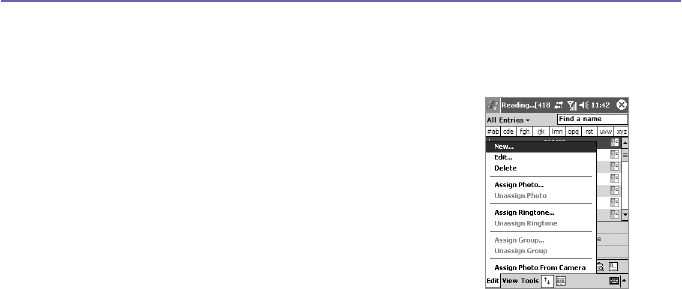
Pocket PC Phone User Manual60
Pocket PC Phone User Manual 61
To manage your groups
You can create a new group, rename, delete, and assign and unassign a photo to a group
by tapping Tools > Manage group.
To assign a contact to a group:
1. Tap
the Start menu
> Programs > Photo
Contacts.
2. Select a contact from the list, or create a new
one by tapping Edit, then New. Contacts
here fully mirror those in Contacts.
3. Tap Edit > Assign Group.
4. Select a group from the list, then tap OK.
To unassign tap Unassign Group on the Edit menu.
Show Contact Names Only
When Show Contact Names Only is selected on the View menu, only the name of each
Contact entry (no phone number or other data) will be listed. The Photo ID (if any) will
still be displayed.

Pocket PC Phone User Manual62
Pocket PC Phone User Manual 63
Set Default Photos...
The Set Default Photos screen lets you assign, unassign, and preview default Photo
IDs to appear for these three situations:
Unknown
photo
This photo will display whenever the phone number of the incoming call
is not known to Caller ID because no phone number was “passed in”
to your Pocket PC Phone . This would occur if the person calling you
has blocked their phone number from being displayed to the receiver,
or has not enabled the broadcast of their Caller ID.
Not-found
photo
This option in the Set Default Photos screen lets you assign a generic
Photo ID to any incoming call from a person whose number is not found
in your Contacts. That is, the phone number of the incoming call is
known, but has no matching entry in your Contacts.
Default
photo
This photo will display when the incoming call is found to be from
a matching entry in your Contacts database, but so far there is no
individually-assigned Photo ID for either that individual Contact entry,
or for the Group it belongs to.
1. To select Set Default Photos, tap Tools > Set Default Photos.
2. Check a circle next to one of the categories, tap Assign.
3. Select a picture, assign settings.

Pocket PC Phone User Manual62
Pocket PC Phone User Manual 63
Assign a Ring tone
This feature allows you to assign ring tones to your Contacts entries, or to the
phonebook entries on your SIM.
1. Tap the Start menu > Programs > Photo Contacts.
2. Select the desired contact from the list, or create a new one by tapping Edit >
NEW.
3. Tap Edit > Assign Ring tone, or tap the Assign Ring tone icon in the toolbar
.
4. Tap Find to list all sound les
.
5. Select a sound le, and tap OK to assign it as a ring tone to the selected contact.
To unassign a ring tone:
1. Tap the Start menu > Programs > Photo Contacts.
2. Select an existing contact entry that you want to remove.
3. Tap
Edit
> Unassign Ring tone, or tap the Unassign Ring tone icon in the toolbar.
Preview
This feature allows you to preview the Photo ID and ring tone you have assigned to a
contact.
1. Tap View > Preview, or tap the Preview icon in the toolbar
.
2. Select View > Play Ring tone during Preview to play the ring tone assigned
to the contact
.
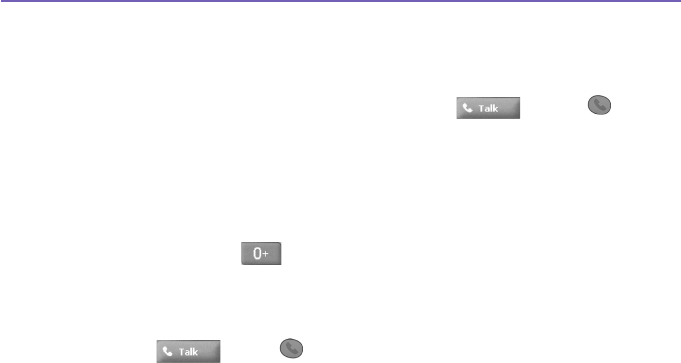
Pocket PC Phone User Manual64
Pocket PC Phone User Manual 65
3.8 Additional Dialing Information
Making an emergency call
Enter the international emergency number 112, then tap or press .
Additional emergency numbers may be included on your SIM card. Contact your operator
for more information.
Making an international call:
1. Tap and hold the key until the + sign appears. The + replaces the international
prex of the country where you are calling.
2. Enter the full phone number you want to dial. It includes country code, area code (without
the leading zero), and phone number.
3. Tap or press .
SIM Tool Kit
This feature allows you to access a range of information services provided by your opera-
tor.
1. Tap
the Start menu
> Programs > STK.
2. A List of services provided by your operator should appear on the page.
3.
To access a service, tap on any item in the list.
Be sure a SIM card is inserted in your phone when accessing SIM Tool Kit (STK).